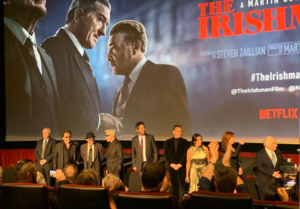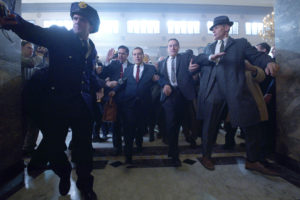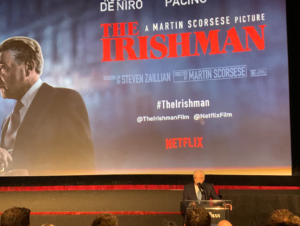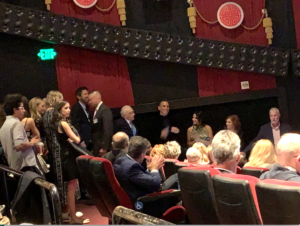A Martin Scorsese Masterpiece Uniting De Niro, Pacino, and Pesci
Martin Scorsese’s “The Irishman,” encapsulates the life of World War II veteran Frank Sheeran (Robert De Niro), a hustler and hitman of the post-war American organized crime syndicate. Spun through decades, Al Pacino shares the spotlight as legendary Teamster union boss Jimmy Hoffa, as does Joe Pesci portraying iconic crime boss Russell Bufalino. Clocking in at three and a half hours, “The Irishman” is a treasure to behold—a true Martin Scorsese masterpiece film—the tone, and appearance echo “Mean Streets” (1973), “Goodfellas” (1990), and “Casino” (1995). Yet, the gangster lifestyle isn’t glamorized; here we’re shown haunting themes of aging, guilt, loneliness, regret, and death. Undoubtedly, the most realized portrait of a ‘criminal’ living with the emotional toll of participating in unethical business practices that conflict with family, religion, and straight-truth.

Screenplay writer Steven Zaillian, “Schindler’s List” (1993), adapted the book “I Heard You Paint Houses” (2004) penned by Charles Brandt, focusing on interviews conducted near the end of Sheeran’s life. In the book, Sheeran confessed to the murder of organized crime-connected Teamsters monarch Jimmy Hoffa—a clouded piece of history that others still have doubts in Sheeran’s admission. Scorsese growing up in Little Italy, a Lower Manhattan neighborhood in New York in the heart of organized crime, apparently believes author Brandt’s findings, unequivocally so, that he’s reunited De Niro and Pacino while coercing Joe Pesci out of retirement.

De Niro’s ‘Scorsese’ history stands as an impressive body of feature film work, spans four decades, boasts numerous awards, and many ranked on lists of the greatest films of all-time. The nine films, “Mean Streets” (1973), “Taxi Driver” (1976), “New York, New York” (1977), “Raging Bull” (1980), “The King of Comedy” (1982), “Goodfellas” (1990), “Cape Fear” (1991), “Casino” (1995), and “The Audition” (2015), a short promotional film. The duo stated at the Los Angeles premiere press conference, of which I attended that they’ve been collaborating on an organized crime film for the past twenty-five years.

Surprisingly, Al Pacino has never worked with Scorsese until “The Irishman,” yet he’s no stranger to acting in gangster films, “Scarface,” “The Goodfather Trilogy” and “Donnie Brasco.” Whereas Joe Pesci has three feature films with Scorsese, “Raging Bull,” “Goodfellas,” and “Casino.” “The Irishman” does signify the historic collaboration between these actors and the famed director.
As stated earlier, this is Frank’s tale; it toggles from 1949 through 2000 and goes back and forth in time continuously. The opening scene is of Frank, at 82 years of age, sitting in a retirement home recalling a story about a road trip to a wedding in 1975 and then shifting back to the 50s, 60s, and 70s, and ultimately returning to the present. Frank’s insider account of his life as a hitman takes us to the dark, violent side of organized crime, its inner workings, hidden social structures, the self-deprecating conflicts, rivalries, and its connections to mainstream politics. His story centers on his close friendship with two men—Russell Bufalino (Pesci), a crime boss, and Teamsters leader Jimmy Hoffa (Pacino).

Jimmy Hoffa, the ambitious International Brotherhood of Teamsters head, consolidated his power in the 1940s and 50s and rose to fame and notoriety as the leader of the country’s most influential union. He was deeply involved in criminal activities and convicted in the 1960s for jury tampering, bribery, and fraud. Released from prison after five years, in a move to regain his power, he provokes his gangland cronies with his arrogance and unpredictability, which lead to his murder.
Russell Bufalino, is the ‘quiet don’ who hides a vast domain of criminal activity behind his Pennsylvania drape and curtain business. Pesci was eager to play Bufalino instead of his typical henchman role. He mentors Frank Sheeran into the ways of the criminal underworld and encourages a friendship between Sheeran and Hoffa that has shattering consequences for all. Their part of organized crime is northeast America, Philadelphia, Pittsburgh, and Detroit.
The film also stars Harvey Keitel, Ray Romano, Bobby Cannavale, Stephen Graham, Anna Paquin, Domenick Lombardozzi, Stephanie Kurtzuba, Kathrine Narducci, Jesse Plemons, and Welker White. Scorsese’s film budget was his highest to date, estimating 150 million to 200 million; there are nearly 200 other characters, and throughout the shoot, almost 6,000 background actors to dress. The flashbacks are aided by new technology that “de-aged” the cast, mainly De Niro, who looks eerily like he’s back in his “Taxi Driver” days. De Niro has said he’s okay with the de-aging as he jokes that it could add 30 years to his career. All three of the main leads play their younger self’s, an amazing sight to behold. The VFX de-aging techniques ILM developed for the film are groundbreaking and very expensive.

The film doesn’t depend too heavily on the de-aging scenes as it does focus on the older years, particularly the ending in which a lonely Frank contemplates his death, in an overly long drawn out scene. However, before the climactic betrayal, Hoffa becomes close to Frank’s family, especially his daughter Peggy (played by Lucy Gallina as a child and Anna Paquin as a young woman), who questions her dad’s late-night disappearances. Lacking noteworthy female characters will generate disappointment in some; it would have been rewarding to see Paquin have a broader narrative than the silent looks and incensed stares. Peggy serves as her dad’s subconscious—a mirror to his sinful behavior—the lack of dialogue does make sense.

In reflection, the lengthy-time one spends with the film does create a real sense of Frank’s life story, the vivid retelling through the decades does fly by, and I’m hard-pressed to say which scenes should have been left on the cutting room floor as they all build to the end. And, by this time, we do know Frank fairly well, sadness does flood the screen, as does the tragedy of the fate of outliving most of the people you love. “The Irishman” is an epic, visionary film that will be studied for years to come, made by an imaginative, brilliant director and three stellar actors that can undoubtedly be ‘oh so proud’ of their remarkable accomplishment of working together to create a masterpiece film.

*Author’s Note: The film is opening in theaters this weekend and will be available on Netflix November 27. My screening, October 24, 2019 was held in Hollywood, California at the TCL Chinese Theater it was the LA Premiere, followed by an after-party at the Roosevelt Hotel and a Press Conference the next day.

Sarah Knight Adamson© November 2, 2019
